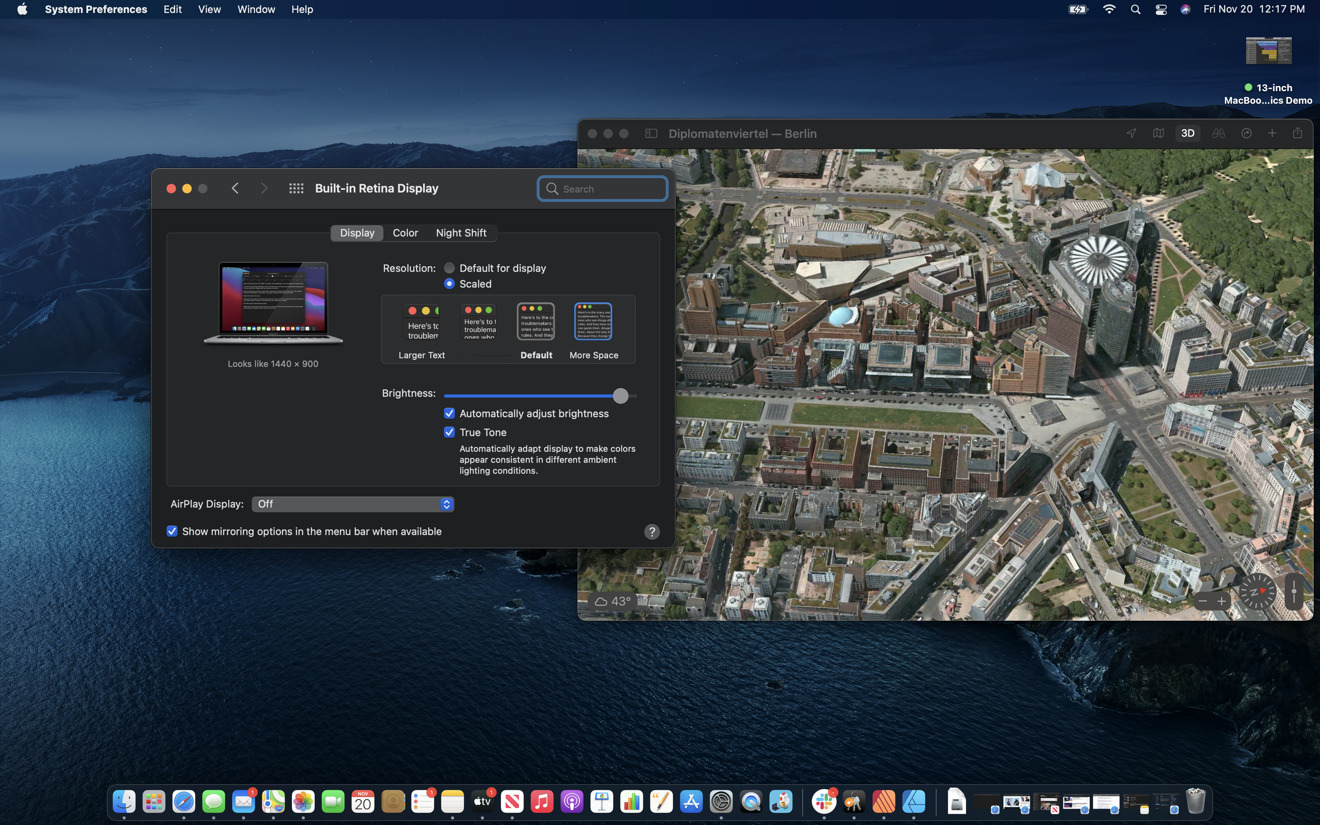Apple's new M1 graphics work makes resolution shifts instantaneous
New Mac models powered by M1 Apple Silicon are not just fast in the conventional sense. They're also much more sophisticated, right down to making settings to their display resolution happen instantly.

Thanks to a host of interrelated architectural changes in both hardware and software, the new crop of Macs using Apple Silicon sport a variety of enhancements that make them look and feel more modern, sophisticated, and refined.
Of particular note is their new graphics pipeline. The machine's native use of Apple's custom GPU optimized for Metal 2-- as well as the same Unified Memory Architecture used to deliver ultra-fast, low power mobile devices from iPhone to iPad Pros-- results in instantaneous, flicker-free changes to video settings.
In the video above, a conventional Intel-based 16 inch MacBook Pro can switch between scaled graphics resolutions with only a momentary blacking out of the screen.
However, the new M1-based MacBook Pro shows off the results of lots of work behind the scenes to enhance this with instantaneous switching between graphics modes. The screen doesn't blank or flicker at all.
The result of many such subtle enhancements makes the new M1 Macs feel luxuriously dialed-in and less "PC." Apple has long worked to make its computers more refined and less "techy" in an industry that has largely ignored the importance of such refinements to instead focus on megabits and gigahertz.
Going forward, Apple's efforts to increasingly take over more of the engineering work that makes up its desktop Mac computers will spread the difference between its Macs and generic PCs with a commonly licensed OS.
Fifteen years ago, it seemed like moving the macOS to essentially commodity Intel hardware based on a standard architecture was Apple's best move, but as the development of years of custom iOS mobile devices--and wearable products like Apple Watch--have demonstrated, the company can blend away the boundary between hardware and software to create more desirable, demonstrably better products that are nicer to use.

Thanks to a host of interrelated architectural changes in both hardware and software, the new crop of Macs using Apple Silicon sport a variety of enhancements that make them look and feel more modern, sophisticated, and refined.
Of particular note is their new graphics pipeline. The machine's native use of Apple's custom GPU optimized for Metal 2-- as well as the same Unified Memory Architecture used to deliver ultra-fast, low power mobile devices from iPhone to iPad Pros-- results in instantaneous, flicker-free changes to video settings.
Changing the scaled display resolution on the new #AppleM1 MacBook (left) is absolutely instantaneous compared to the delay and screen blanking required by the Intel graphics on the 16 inch MacBook Pro (right) pic.twitter.com/YybbPF09TF
-- Daniel Eran Dilger (@DanielEran)
In the video above, a conventional Intel-based 16 inch MacBook Pro can switch between scaled graphics resolutions with only a momentary blacking out of the screen.
However, the new M1-based MacBook Pro shows off the results of lots of work behind the scenes to enhance this with instantaneous switching between graphics modes. The screen doesn't blank or flicker at all.
The result of many such subtle enhancements makes the new M1 Macs feel luxuriously dialed-in and less "PC." Apple has long worked to make its computers more refined and less "techy" in an industry that has largely ignored the importance of such refinements to instead focus on megabits and gigahertz.
Going forward, Apple's efforts to increasingly take over more of the engineering work that makes up its desktop Mac computers will spread the difference between its Macs and generic PCs with a commonly licensed OS.
Fifteen years ago, it seemed like moving the macOS to essentially commodity Intel hardware based on a standard architecture was Apple's best move, but as the development of years of custom iOS mobile devices--and wearable products like Apple Watch--have demonstrated, the company can blend away the boundary between hardware and software to create more desirable, demonstrably better products that are nicer to use.



Comments
Video work?
Music?
Mission Control for SpaceX?
Fact-checking Trump’s tweets?
Apple has basically started the end of the computer as we know it. Imagine what else an M1 board could slip into. Imagine how much more an M class chip could hold in the way of component parts or variations thereof. The traditional PC, i.e. motherboard and various parts will be obsolete in a matter of years.
http://i1-news.softpedia-static.com/images/news2/Emergency-Patch-for-WinCC-Issued-by-Siemens-466026-4.jpg
https://zerosecurity.org/wp-content/uploads/2014/01/control-room-660x288.jpg
Let's not forget ...
https://www.firstpost.com/wp-content/uploads/2016/03/batcave5.jpg
This is a cool demo but in reality most people don't change their resolution all that often, so it's of limited impact. I'm more interested in what it may mean in terms of graphics performance.
that would take more than 6 monitors...
Looking at their user base, they are more creative professionals and in a lesser extend gamers, so the M1, even targeted at the lower to mid end, make sure things like video decoding, video rendering, speed of booting apps etc are addressed to make sure the perceived speed island smoothness is there.
Sure, its GPU is very modest for gaming but they simply prioritized it differently as part of the whole package.
you beat me to it. I was just getting ready to type a similar response.
doubt many here even know what computer and OS i am talking about. However there were things it could do that even a 2020 mac still can’t.
In order to "change" for each window, it has to be set at the highest native resolution and scale accordingly.
That's exactly what MacOS does with its Retina "default" display - the apps are literally scaled up to imitate the older resolution yet maintaining the highest native resolution. And in photoshop/lightroom, the menu elements seem to be the same resolution as the older one but the photos are at its highest resolution.
Safari browser is the same - if it doesn't recognize "Retina" attribute in image, it will assume it's the standard monitor. If it sees the attribute then it will display its full resolution in its glory.
I am sure MacOS already have that baked in but not allowing users to just pick resolution for each window. It just adds more steps for users when Apple is focused on making it as simple as possible.
And on new Intel hardware:
When we said we would support Intel systems for years to come, that was talking about the operating system… What we did say from a system standpoint, is that we still had Intel systems that were in the pipeline, that we were yet to introduce. And certainly that was so. The very next month, we introduced an Intel-based iMac
Right, are they saying that's it for new Intel-based hardware?